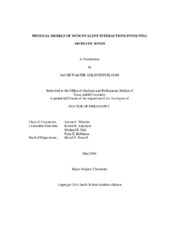| dc.description.abstract | Noncovalent interactions involving π-systems play a vital role throughout
chemical and biological processes. These π-interactions can be found in organic
photovoltaics and electronics as well as govern many protein and DNA interactions. A
fundamental and physically meaningful model of these interactions is necessary for the
efficient exploitation of these materials and rational drug design. First, the role of
aromaticity in π-stacking, cation/π, and anion/π interactions is investigated. Aromaticity
weakly hinders π-stacking and greatly hinders anion/π interactions, while greatly
enhancing cation/π interactions. Nonaromatics, therefore, present themselves as a new
target in design for π-stacking and anion/π interactions.
The well-established local direct interaction model for π-stacking that substituent
effects are due solely to local electrostatic changes has also been expanded herein. First,
we show that the local direct model for substituent effects in π-stacking also applies to
polar XH/π interactions. The nonpolar XH/π interactions vary little with substituent,
depending only on changes in dispersion. The energetic changes of both sets of XH/π
interactions follow well-known substituent constants. Next, the local direct interaction
model is expanded to the use of electric fields to reconcile unusual similarity in the
substituent effects between benzene, triazine, and borazine. Substituent effects for
different rings are similar as long as the electric fields of those rings are similar in the
location of the substituent. In fact, the substituent effect scales proportionally to the relative strength of those fields. Lastly, in an analysis on anion/π complexes with a variety of azines and benzene, it is shown that changes induced through the substitution of a carbon-hydrogen bond with nitrogen are almost exclusively from the nuclear charge differences. This reconciles well with the local direct interaction model. | en |


